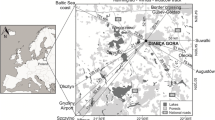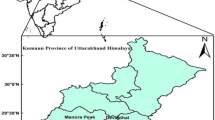Abstract
The paper presents unique data of a 12-year (2001-2012) monitoring of the mass concentration of atmospheric aerosol and concentrations of organic carbon (OC), elemental carbon (EC), and total protein (TP) in it at the Klyuchi site (Novosibirsk region). It was found that aerosol mass concentrations, OC, and OC/EC ratio have an increasing trend, and TP has a decreasing trend. Seasonal changes in these concentrations and OC/EC and TP/OC ratios are also identified. The comparison of data obtained and recently published for other Asian and European regions show a good agreement between the values and trends for certain regions and the absence of agreement for other regions.
Similar content being viewed by others
References
G. M. Hidy, Aerosols. An Industrial and Environmental Science (Academic Press, Orlando, 1984).
Environmental Chemistry, Ed. by O.M. Bokris (Khimiya, Moscow, 1978) [in Russian].
C. Pio, M. Cerqueira, R. V. Harrison, T. Nunes, F. Mirante, C. Alves, C. Oliveira, A. Sanchez De La Campa, B. Artinano, and M. Matos, “OC/EC ratio observations in Europe: re-thinking the approach for appointment between primary and secondary organic carbon,” Atmos. Environ. 45(34), 6121–6132 (2011).
Y. Cheng, K.-B. He, F.-K. Duan, M. Zheng, Z.-Y. Du, Y.-L. Ma, and J.-H. Tan, “Ambient organic carbon to elemental carbon ratios: Influences of the measurement methods and implications,” Atmos. Environ. 45(12), 2060–2066 (2011).
G. Grivas, S. Cheristandis, and A. Chaloulakou, “Elemental and organic carbon in the urban seasonal and diurnal variations and estimates of secondary organic carbon,” Sci. Total. Environ. 414, 535–545 (2012).
V. R. Després, J. A. Huffman, S. M. Burrows, C. Hoose, A. S. Safatov, G. A. Buryak, J. Fröhlich-Nowoisky, W. Elbert, M. O. Andreae, U. Pöschl, and R. Jaenicke, “Primary biological aerosols in the atmosphere: observations and relevance,” Tellus B. Chem. Phys. Meteorol. 64, 1–58 (2012). doi: 10.3402/tellusb.v64i0.15598
A. S. Safatov, G. A. Buryak, I. S. Andreeva, S. E. Olkin, I. K. Reznikova, A. N. Sergeev, B. D. Belan, and M. V. Panchenko, “Atmospheric bioaerosols,” in Aerosols-Science and Technology, Ed. by I. Agranovski, (Wiley-VCH, Weinheim, 2010), pp. 407–454.
K. Wark and C. Warner, Air Pollution, its Origin and Control (Harper and Row, New York, 1976).
M. E. Berlyand, Forecast and Control of Atmospheric Pollution (Gidrometeoizdat, Leningrad, 1985) [in Russian].
M. Viana, C. Reche, F. Amato, A. Alastuey, X. Querol, T. Moreno, F. Lucarelli, S. Nava, G. Cazolai, M. Chiari, and M. Rico, “Evidence of biomass burning aerosols in the Barcelona urban environment during winter time,” Atmos. Environ. 72, 81–88 (2013); http://dx.doi.org/10.1016/j.atmosenv.2013.02.031
M. P. Keuken, M. Moerman, M. Voogt, M. Blom, E. P. Weijers, T. Röckmann, and U. Dusek, “Source contributions to PM2.5 and PM10 at an urban background and a street location,” Atmos. Environ. 71, 26–35 (2013), http://dx.doi.org/10.1016/j.atmosenv.2013.01.032
T. Saud, M. Saxena, D. P. Singh, Dahiya M. Saraswati, S. K. Sharma, A. Datta, R. Gadi, and T. K. Mandal, “Spatial variation of chemical constituents from the burning of commonly used biomass fuels in rural areas of the Indo-Gangetic Plain (IGP), India,” Atmos. Environ. 71, 158–169 (2013), http://dx.doi.org/10.1016/j.atmosenv.2013.01.053
P. Zhao, F. Dong, Y. Yang, D. He, X. Zhao, W. Zhang, Q. Yao, and H. Liu, “Characteristics of carbonaceous aerosol in the region of Beijing, Tianjin, and Hebei, China,” Atmos. Environ. 71, 389–398 (2013), http://dx.doi.org/10.1016/j.atmosenv.2013.02.010
M. F. D. Gianini, C. Piot, H. Herich, J.-L. Besombes, J.-L. Jaffrezo, and C. Hueglin, “Source apportionment of PM10, organic carbon and elemental carbon at Swiss sites: An intercomparison of different approaches,” Sci. Total Environ. 454–455, 99–108 (2013).
S. Caserini, S. Galante, S. Ozgen, S. Cucco, K. de Gregorio, and M. Moretti, “A methodology for elemental and organic carbon emission inventory and results for Lombardy region,” Sci. Total Environ. 450–451, 22–30 (2013).
S. A. Popova, V. I. Makarov, N. V. Bashenkhaeva, and T. V. Khodzher, “Comparison of results of measuring carbon content of atmospheric aerosols by methods of reaction gas chromatography and dry burning,” Chem. Sustain. Develop. 15(1), 97–103 (2007).
M. A. Bizin, S. A. Popova, O. V. Chankina, V. I. Makarov, M. P. Shinkorenko, B. S. Smolyakov, and K. P. Kutsenogii, “The effect of forest fires on mass concentration, disperse and chemical composition of atmospheric aerosols on a regional scale,” Opt. Atmosf. Okeana 26(6), 484–489 (2013).
W. W. You, R. P. Haugland, D. K. Ryan, and R. P. Haugland, “3-(4-Carboxybenzoyl)Quinoline-2-Carboxaldehyde, a reagent with broad dynamic range for the assay of proteins and lipoproteins in solution,” Annal. Biochem. 244(2), 277–282 (1997).
V. S. Kozlov, M. V. Panchenko, and E. P. Yausheva, “Time content variations of submicron aerosol and soot in the near-ground layer of the West Siberia atmosphere,” Atmos. Ocean. Opt. 20(12), 987–990 (2007).
V. S. Kozlov, M. V. Panchenko, and E. P. Yausheva, “Diurnal variations of the submicron aerosol and black carbon in the near-ground layer,” Atmos. Ocean. Opt. 24(1), 30–38 (2011).
Author information
Authors and Affiliations
Corresponding author
Additional information
Original Russian Text © A.S. Safatov, G.A. Buryak, S.E. Olkin, I.K. Reznikova, V.I. Makarov, S.A. Popova, 2013, published in Optica Atmosfery i Okeana.
Rights and permissions
About this article
Cite this article
Safatov, A.S., Buryak, G.A., Olkin, S.E. et al. Analysis of monitoring data on organic/elemental carbon and total protein in ground air layer aerosol in the south of Western Siberia. Atmos Ocean Opt 27, 164–168 (2014). https://doi.org/10.1134/S1024856014020122
Received:
Published:
Issue Date:
DOI: https://doi.org/10.1134/S1024856014020122




